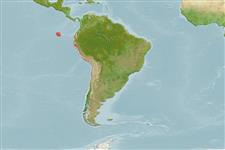Issue
Family placement uncertain; see also the genus account: incertae sedis in Percoidei, Johnson, 1984.
Environment: milieu / climate zone / depth range / distribution range
Écologie
marin; profondeur 10 - 55 m (Ref. 104864). Tropical; 2°N - 54°S, 92°W - 70°W
Southeast Pacific: Peru to Chile and the Galapagos Islands.
Taille / Poids / Âge
Maturity: Lm ? range ? - ? cm
Max length : 50.0 cm SL mâle / non sexé; (Ref. 28023); poids max. publié: 1.7 kg (Ref. 53696)
Épines dorsales (Total): 10; Rayons mous dorsaux (Total): 10-11; Épines anales 3. Deep, compressed body, brown, somewhat lighter on the lower half; a dark streak along the lateral line. Large mouth, compressed head. Serrated preopercular margin. Lateral line complete. Small scales. Caudal fin emarginate (Ref. 28023).
Found near drop-offs and among rock out-croppings over sand and rock, in depths greater than 10 meters. Feeds on small fishes and crustaceans (Ref. 28023).
Life cycle and mating behavior
Maturité | Reproduction | Frai | Œufs | Fécondité | Larves
Grove, J.S. and R.J. Lavenberg, 1997. The fishes of the Galápagos Islands. Stanford University Press, Stanford, 863 p. (Ref. 28023)
Statut dans la liste rouge de l'IUCN (Ref. 130435)
Menace pour l'homme
Harmless
Utilisations par l'homme
Pêcheries: pêcheries vivrières
Plus d'informations
Noms communsSynonymesMétabolismePrédateursÉcotoxicologieReproductionMaturitéFraiRassemblement de ponteFéconditéŒufsDéveloppement de l'œuf
RéférencesAquacultureProfil d'aquacultureSouchesGénétiqueElectrophoresesHéritabilitéPathologiesTraitementNutrientsMass conversion
CollaborateursImagesStamps, Coins Misc.SonsCiguateraVitesseType de nageSurface branchialeOtolithesCerveauxVision
Outils
Articles particuliers
Télécharger en XML
Sources Internet
Estimates based on models
Preferred temperature (Ref.
123201): 16.5 - 23.1, mean 20.1 °C (based on 24 cells).
Phylogenetic diversity index (Ref.
82804): PD
50 = 1.0000 [Uniqueness, from 0.5 = low to 2.0 = high].
Bayesian length-weight: a=0.01230 (0.00579 - 0.02614), b=3.00 (2.81 - 3.19), in cm total length, based on LWR estimates for this species & (Sub)family-body (Ref.
93245).
Niveau trophique (Ref.
69278): 4.3 ±0.6 se; based on diet studies.
Fishing Vulnerability (Ref.
59153): Moderate vulnerability (44 of 100).
Nutrients (Ref.
124155): Calcium = 92.6 [48.5, 191.1] mg/100g; Iron = 1.16 [0.58, 2.10] mg/100g; Protein = 18.1 [16.1, 19.8] %; Omega3 = 0.255 [0.149, 0.447] g/100g; Selenium = 37.4 [19.4, 79.9] μg/100g; VitaminA = 48.9 [15.7, 164.2] μg/100g; Zinc = 1 [1, 1] mg/100g (wet weight);
